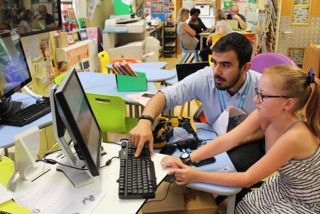 Glafkos was voted the winner of the Medical Physics Zone in March 2015. We asked him to report back on how he used his £500 prize money and here is what he said…
Glafkos was voted the winner of the Medical Physics Zone in March 2015. We asked him to report back on how he used his £500 prize money and here is what he said…
Last year I was humbled by being selected the winner of the Medical Physics Zone and it was an amazing, exhilarating and breath holding experience! I have never typed so fast in my life, so many questions!
I work in a hospital as a Medical Physicist. So my initial plan for the prize money was to create replicas of our scanners using Legos and Raspberry Pis so that children visiting the hospital could see how our scanners work. I thought this would be helpful for children who are scared of having a scan done as well!

The children got to write their own code for the robotic arm controlled by the Raspberry Pi
When I won the zone, and along with it the £500 prize money, I had second thoughts. I thought- why should I have all the fun playing with Legos and Raspberry Pis and not the children themselves? So then I thought why don’t I show children what Raspberry Pis and coding can do? This would tie in very well with the recent push for teaching coding to children across the country.
At first I contacted a number of schools to see whether they would be interested in the project but had no luck. I then found out that our own hospital, King’s College Hospital in South East London has it own School Room for children who are staying at the hospital and so it all began: I bought two Raspberry Pi kits , a robotic arm (yes, a robot) and a Pi camera and, with the help of the teachers, organised coding teaching sessions for children at the hospital.

Fully certified Bumblebee programmers!
Wait, but what are Raspberry Pis? Raspberry Pis are a series of motherboards the size of a credit card. They perform the same operations as a home computer, and have USB ports to plug in a mouse or keyboard. They are aimed at teaching coding to children. To make it cooler and even more exciting for the children I bought the robotic arm as well which I named “Bumblebee” for obvious reasons.
I did a number of sessions with the children for about an hour a day. I taught them what a Raspberry Pi is, and what coding is. How coding drives everything electrical and automated around us and why it is important in our modern world. Then they started coding with the robotic arm and moving things around, which was really good. Some of the children became so good at it they wrote codes on the Raspberry Pi that made the robotic arm pick up pens from pen holders and trapped Lego men in pots. Check out the video below to see how great the children were at working out their code!
The sessions in my opinion had two outcomes: First, the children were able to learn the basics and foundations of coding while playing with the robotic arm and coding with the Raspberry Pi. They also got an idea how science and computing can be applied in healthcare- in this case robotics! The other, and most important outcome, was that they were able to escape the normal hospital routine and environment whilst doing this. It gave them, I believe, the opportunity for at least a small period of time to forget about their conditions and focus on controlling Bumblebee.
I would like to take this opportunity to thank everyone who contributed in the creation and running of the I’m A Scientist Get Me Out of Here competition and Medical Physics Zone- the I’m a Scientist Team, the Institute of Physics and Engineering in Medicine and the Institute of Physics. I’m planning to continue the Raspberry sessions during the new academic year at the hospital as the school teachers are really keen and want to support the project all the way!
Want the chance to win £500 for your own outreach project? Apply now for the next I’m a Scientist event!

